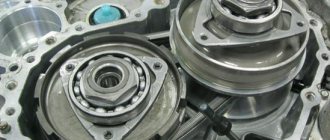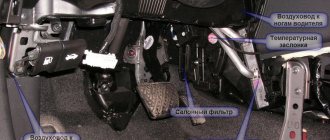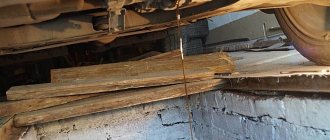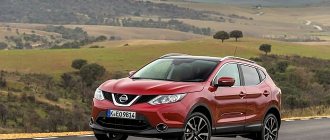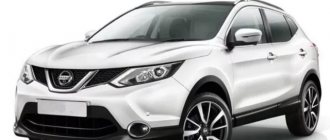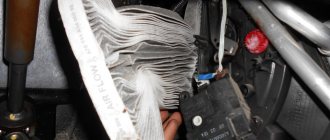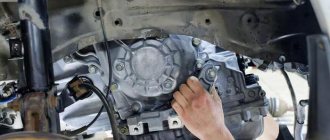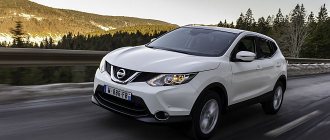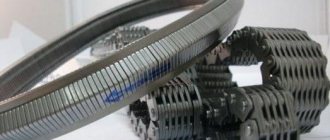Home / Crossovers
Back
Published: 07/31/2018
Reading time: 8 min
0
15359
Rate this article
The products of the Japanese automobile manufacturer have been very popular among domestic vehicle enthusiasts for several years now. This is especially true for the Nissan Qashqai crossover. This car has good cross-country ability, stylish design and good technical parameters, as a result of which the demand for it is quite high.
However, before purchasing a car, it is important to know everything about it. Including what kind of gearbox will be installed on the car. In this article we will answer the question: “Qashqai: automatic or CVT?”, and also discuss the features of operating the gearbox on this vehicle .
- What boxes are placed on Qashqai
- Features of the Nissan CVT
- How long does a CVT run on a Nissan Qashqai?
- How to extend the service life of a gearbox
- Nissan Qashqai CVT: problems
- How to identify problems with the CVT
- A short summary
What boxes are placed on Qashqai
Many people are interested in the following question: “Nissan Qashqai: automatic transmission or CVT?” . Before answering it, it is necessary to understand the main differences between these concepts. While the term manual gearbox is clear to everyone, few know what a variator or automatic transmission is, and how they differ.
An automatic transmission with hydraulic filling has already become a classic version of an automatic machine.
In the case of such a device, the gears switch independently; you just need to select the correct mode. It should be noted that the machine operates relatively smoothly and predictably. At the same time, such equipment is quite cumbersome, it negatively affects the dynamics of the car, and also increases the level of fuel consumption.
The main difference between a variator (or, as it can also be called, CVT) is the absence of gears. Instead, the device is equipped with a pair of sliding pulleys and a metal belt that connects them. Based on the characteristics of movement, the diameter of the pulleys changes smoothly. As a result, such a transmission has no gears at all. It is most convenient to operate such a box. At the same time, fuel consumption on cars with a CVT is an order of magnitude lower. Often CVTs are even more economical than manual ones. On the other hand, with such a gearbox it is not very convenient to drive in traffic jams. In addition, the device does not like constant slipping.
It will also be interesting to read: Renault Duster or Hyundai Creta, which is better?
So, we have described the main difference between the concepts. Thus, if we consider such a question as: “Nissan Qashqai: automatic or CVT?”, then a new CVT model is installed on such cars. Whether this is good or bad, we will discuss below.
Video recommendations from a specialist about the reliability of the Nissan Qashqai variator:
Review of Nissan Qashqai 2.0 2WD (2007)
Greetings to everyone who likes to read reviews on this site. I’ll add one more review, this time about the car I currently own, namely the Nissan Qashqai. I will try not to write a dry list of pros and cons, as in previous reviews, but to state my impressions.
As usual, first the background of the purchase: My previous car was a Chevrolet Aveo, which regularly took me wherever I needed it, didn’t break down and didn’t ask for extra money. But after the car turned 3 years old, I began, although not very actively, to select a replacement. I wanted more space inside, a more powerful engine, most likely an automatic transmission and a leather interior, so that it would be easier to wipe off the marks from my little son’s feet. I didn’t want a large sedan, I didn’t like a single minivan, and jeeps/crossovers started to appear.
I wanted to fit into the budget of 800t. rub., but taking into account post-crisis prices, the choice most likely came down to a used car. The more reviews I read, the more I became convinced that I absolutely did not need a serious rogue, because... The advantages of serious SUVs bring with them disadvantages that are undesirable for me: poor handling and increased consumption. Maybe I could have chosen this way for a long time, but I decided, as often happens, by accident. Before the new year, 2011, one of my colleagues in a tavern asked if I had any friends who wanted to buy his wife’s Qashqai. During the conversation, it turned out that given the amount of time he spends in Europe, in Russia it is much more profitable for him to travel by taxi, so he decided to sell both his car and his wife’s car. His CRV has only 20k miles. for three years there was a queue of people interested, and I had previously booked the Qashqai for myself, and, having gone to evaluate the car at the nearest Nissan dealer, I bought it in a couple of days. The equipment is almost maximum: two-liter engine, CVT, leather interior, 6 airbags, dual-zone climate control, keyless entry, parking sensors, original xenon, casting, etc., etc. Of the possible options, only all-wheel drive and navigation are missing . As a result, I got a car that corresponded to my desires, with a mileage of 45,500 km, an extremely clear history and a slight wear on the bumper, which I was too lazy to do under comprehensive insurance.
I picked up the car in December on summer tires (the car had not been driven since the fall), so the first thing I did was go to the tire service. It was there that the first surprises awaited me. Pleasant: the three-year-old Nokian Hakkapelita tires looked as if they were new, from which one could draw a conclusion about the driving style and winter runs of the previous owner. And unpleasant: flipping the tires cost 2500 rubles, while on the Aveo the same operation cost a maximum of 1000 rubles. You will have to get used to the fact that, despite its size, this car formally belongs to crossovers/jeeps, and the service prices are appropriate.
The first feeling after the purchase is what good sound insulation it has! Now I’m used to it, but after Aveo the contrast was very striking. The noise starts to be annoying at speeds from 130-140. I really like the interior design - soft plastic and leather everywhere, a strict interior, it feels like a premium German car, strictly and tastefully. The only thing that spoils the impression is the orange round piece of the on-board computer in the middle of the dashboard, and the instrument wells themselves are decorated somehow cheaply. Apparently the Nissan people themselves realized this, because... on the restyled Qashqai, the dashboard is designed much nicer.
I found the seating position without difficulty, the seat back has a cool profile, reliably fixing your back in turns, but I would like the seat cushion to be longer, because... my knees hang a little in the air (height is 187), and during long trips this will not have the best effect on fatigue. By the way, the colleague from whom I bought the car found the seats cramped, although he is thinner than me, so comfort is most likely a matter of habit. By the way, I have more than once heard complaints about the cramped interior of the Qashqai. I can’t call it cramped, although even the Aveo wins in terms of space in the driver’s seat. It seems to me that a comparison with a suit or jeans that perfectly fits the figure would be appropriate: there doesn’t seem to be that feeling of airiness that Bermuda shorts, for example, give, but at the same time it’s very comfortable, and you don’t want to take off such a suit. I experienced similar sensations in a BMW three-ruble car, riding as a passenger - comfortable, but never spacious. Some people will like it, some won't. The rear seats are profiled for two passengers, who can fit like in any C-class car: it’s not spacious, but you don’t have to feel discriminated against. In the same CRV, for example, there seems to be 20 cm more space in the back, so the competition for space in the rear seats with full-fledged large crossovers Qashqai will lose outright. It also loses in the comparison of trunks - the trunk is also typical for a hatchback: a stroller fits in, and there is room for several bags from the supermarket; You can't fit an elk carcass, a boat, or a tent in there. The Qashqai+2 has a much larger trunk, but, in my opinion, it doesn’t look as harmonious as a regular Qashqai, and it costs even more.
I haven’t said anything yet about the engine + gearbox pair. It’s time to write a few words about them: the engine is a reliable 2-liter naturally aspirated engine, not enough stars from the sky: 141 hp, 196 N/m. What's good about it is the pickup from the bottom, but at maximum speed it turns sour. This makes it quite easy to accelerate and move at a ragged pace, but not race the quarter mile. =)
I had never driven a car with a CVT before, and didn’t know whether it was a plus or a minus. Now I can say for sure that from the point of view of operation, the CVT is an absolute plus. I can’t compare it with modern 6- and 8-speed automatic transmissions and DSG, but it definitely wins the comparison with Korean/Japanese four- and five-speed automatic transmissions. During normal driving, the box tries to drop the revolutions to one and a half to two thousand for the sake of fuel economy, but when spurred on, it easily spins the engine up to 4 thousand, and when pushing through the virtual step, to maximum speed. It was also written in the manual that the variator adapts to the driver’s driving style. In practice, this only translates into the fact that if you were jostling in the city in traffic jams, and then went onto the highway, you will have to press the gas pedal harder for the necessary acceleration. For me, it would be better if there was no such adaptability; it would be better if they added a sport mode. On the highway, the main advantage of this gearbox manifests itself: when driving at a speed of 120 km/h, it holds about 2000 rpm, and at a speed of 150 km/h about 3000!!! Naturally, I’m talking about a smooth ride; when accelerating, the revs rise higher. The variator also has 6 virtual gears, switched by a rocker lever, but the real probability of using them tends to zero; the automatic mode is always enough for the box.
Another advantage of this car is its ground clearance of 20cm, short overhangs and plastic edging around the perimeter, which allows you to climb curbs, park in places where cars do not go, drive on icy ruts left by other cars without scraping the bottom, etc. . Regarding possible comments that buying a crossover without all-wheel drive is utter stupidity, I will voice my opinion. On modern crossovers, the PP mainly helps control in difficult road conditions; in serious dirt it will still help, and in weak dirt, ground clearance is much more important than possible blockages. Since 95% of the time I move around Moscow, and I can also drive to the dacha on the Oka River, I consider the choice justified for myself, and if I were choosing a new car from the showroom, I would most likely prefer to save money by not using all-wheel drive.
Despite the car's elevation above the road, it handles like a regular passenger car; the elastic suspension allows for slight nosedive during hard braking, but does not allow serious rolls in corners. Both in turns and on a straight line, the front MacPherson strut and the rear multi-link seem to cling to the road, allowing you to feel very confident. The only big drawback in handling is the electric power steering with very mediocre feedback. But I really liked the brakes, which make it easy to control the force and stop the car at any speed. Of all the cars I have ever driven, Kashkaevsky brakes left the most pleasant impression.
Some more general impressions of the car:
— The glove compartment is of normal size, an A4 folder fits easily.
— The climate control works almost flawlessly, with the exception of the speed at which the interior warms up: on the Aveo, warm air began to blow earlier.
— The armrest with a lid that moves longitudinally on a slide turned out to be quite spacious.
— It’s strange to see only one automatic window in an expensive car. All windows, except the driver's, do not have automatic closers.
— A nice feature of the standard immobilizer: locking the locks when you start driving.
— There are all sorts of electronic assistants: ABS, ESP, Brake Assist, EBD, which try to protect against everything: you can’t accelerate normally in winter, you can’t take a turn with drift, it’s good that at least there’s a button to turn off ESP. So far I have discovered only one positive effect from its operation: when entering a turn at too high a speed, the car seems to be screwed into the turn like a rear-wheel drive one.
— A strange choice of radio for a modern car: there are no connectors for connecting external sound sources at all - this is bad; but there is a CD changer for 6 discs that fits in the body of the radio itself, which is good; but only regular CDs are supported - this is bad; convenient control of the radio on the steering wheel, and on the body of the radio itself there are convenient large keys - this is good; but the sensitivity of the radio, even in the city, is terrible, despite the presence of an external antenna - this is very bad. I won’t say anything about the sound quality - I’m absolutely not a music lover.
— It’s now very convenient to use your phone while driving. Via Bluetooth, it automatically connects to the car's audio system, and to make a call, just press the corresponding button on the steering wheel. Blackberry, as it turns out, has a very convenient implementation of voice dialing; just say “call <contact name>”, and the phone itself will recognize the corresponding entry in the phone book. On other phones, it was necessary to make voice tags, and they were not recognized on the first try. So now I can make calls without taking my eyes off the road at all.
— The light sensor does not turn off, why it is needed is unclear, I always travel with my neighbor.
— The rain sensor also works as it pleases. Often you have to interfere with his work.
It’s too early to talk about reliability and costs, since my ownership experience is not enough for this. Let me just say that the previous owner did not have a single reason to contact the service, except for undergoing maintenance (8-12 thousand rubles at the dealer). Problems with the suspension, which, as far as I know, is the weak point of the Kashkai, were not noticed. Perhaps this is because the car has never left Moscow. The only problem that has been noticed is that after switching from headlights to low beam, the left headlight does not always light up, but since the light switch is always set to the “auto” position, and the low beam is constantly on, there is no desire to even understand the roots of the problem.
Fuel consumption with my far from relaxed driving style is about 13.5 liters in the city, taking into account warm-ups and traffic jams, and about 9-10 on the highway at an average speed of 120-140 km/h. Given the gearbox's tendency to rev low, I think a calm driver can easily reduce these numbers by a couple of liters.
Features of the Nissan CVT
The variator for the Nissan Qashqai was developed by employees of the famous Japanese automaker together with the Jatco company, which specializes in gearboxes.
It is based on the Multitronic transmission, which has proven its reliability and durability on cars from the Audi brand.
At the same time, this device is quite innovative, since the use of improved components has made it possible to reduce the dimensions of the unit by 10 percent, as well as greatly reduce its weight when compared with previous models.
The peculiarity of the operation of such a gearbox is based on the possibility of simultaneously changing the diameter of the drive and driven shafts.
In this case, everything happens automatically, based on the performance of the power unit. At the moment the car starts, the diameter of the drive shaft is minimal, and the driven shaft is the largest. During acceleration, the diameter of the drive shaft increases and the driven shaft decreases, due to which the gear ratio decreases. The device reacts very sensitively to all changes in the motor, there are no jerks - everything happens very smoothly. This ensures optimal vehicle dynamics and power.
How long does a CVT run on a Nissan Qashqai?
Despite the fact that CVTs are considered quite reliable, things didn’t work out right away on Nissan Qashqai cars . There were two mass failures of similar units: in 2012 and 2014. At the same time, new firmware helped correct this situation. Now the devices are working correctly, so there is no need to worry about their reliability. Moreover, the manufacturing company provides a guarantee of up to 100 thousand kilometers. The Jacto brand, which supplies gearboxes for Nissan, guarantees high-quality gearbox operation for up to 120 thousand kilometers.
It will also be interesting to read: Description and characteristics of the Nissan Patrol Y60
But in fact, the resource of the Nissan Qashqai variator is even greater. Based on the reviews of the owners, no problems arise with this unit until the car has driven more than 200 thousand km. And even after this, serious breakdowns do not occur immediately, but after a long time. As a rule, a major overhaul of the power unit is required earlier than restoration of the variator.
At the same time, in order for the CVT to function properly, it is necessary to carry out regular maintenance.
In particular, it is important to follow the manufacturer’s recommendations for changing the oil every 60 thousand km.
Service
You should not neglect scheduled maintenance of your Nissan Qashqai 2.0, as this will help avoid possible problems in the future.
Planned maintenance consists of the following operations:
- Checking the external oil filter cartridge. If necessary, it is worth replacing, and this is done after 30–50 thousand km.
- Checking the oil level and itself. If necessary, it must be replaced, and the need for this occurs after 60–100 thousand km.
There is also work in the form of unscheduled maintenance. It is very difficult to make them with your own hands; you need to have good knowledge in this matter. Therefore, you should only list the work that can be carried out on your car. Basically it's replacing something:
- Internal oil filter.
- Speed sensor.
- The high pressure pump valve of the pump itself.
- Cones.
- Belt (sometimes a metal or rubber variator belt, sometimes a chain).
- Pump and axle shaft seals.
- Selenoidov.
- Friction clutches and sealing rings.
- Stepper motor.
- Shaft bearings.
If shifting gears is difficult, adjustment will be required.
How to extend the service life of a gearbox
You can also follow a number of simple rules that will help significantly increase the life of your variator:
- Avoid driving fast on poor road surfaces or ice drifts;
- Under no circumstances should you skid;
- You should not transport heavy trailers with a carrying capacity of more than 500 kilograms;
- try not to pull other vehicles out of difficult places;
- do not overheat the variator;
- Avoid sudden acceleration until the car is well warmed up (this especially applies to operating the car in winter).
Thanks to this, it will be possible to avoid significant damage to the CVT.
Nissan Qashqai CVT: problems
But, although at the moment the reliability of the Nissan Qashqai CVT leaves no doubt, even with such a gearbox certain problems may arise. The main problems of such a device can be divided into two groups:
- electronic (breakdown of the gearbox control unit, failure of the stepper motor, jamming of the electrovalves)
- mechanical (clogged oil cooler, dirt getting into the oil pump, worn bearings).
In the event of electronic errors, the variator will be locked in a certain position, making it possible to drive the car to the repair site. Mechanical problems with a car, as a rule, occur in the absence of regular maintenance of the device and harsh operation of the gearbox off-road or in winter. Basically, mechanical damage does not lead to a transition to emergency mode.
It will also be interesting to read: Review of the new Nissan Qashqai: the best crossover from Japan in 2022
Specifications cvt8 Jatco JF016E
| Type | variable speed drive |
| Number of gears | ∞ |
| For drive | front/full |
| Engine capacity | up to 2.5 liters |
| Torque | up to 250 Nm |
| What kind of oil to pour | Nissan CVT NS-3 |
| Lubricant volume | 7.9 l |
| Change of oil | once every 40,000 km |
| Replacing the filter | once every 40,000 km |
| Approximate resource | 220,000 km |
How to identify problems with the CVT
Among the main symptoms that indicate that the variator is not working correctly are:
- car slipping even during normal weather;
- glowing indicator of emergency operation mode of the gearbox;
- decrease in the smoothness of the car (the car began to twitch);
- strong jerks when changing speed;
- extraneous noises and other sounds coming from the transmission;
Another sign is that the car begins to stall frequently at intersections.
As soon as you discover one of these problems, you should immediately contact a service center for diagnostics and further repairs. It is worth understanding that problems with the gearbox can lead to quite serious situations on the road, so it is better not to delay the restoration of this unit.
